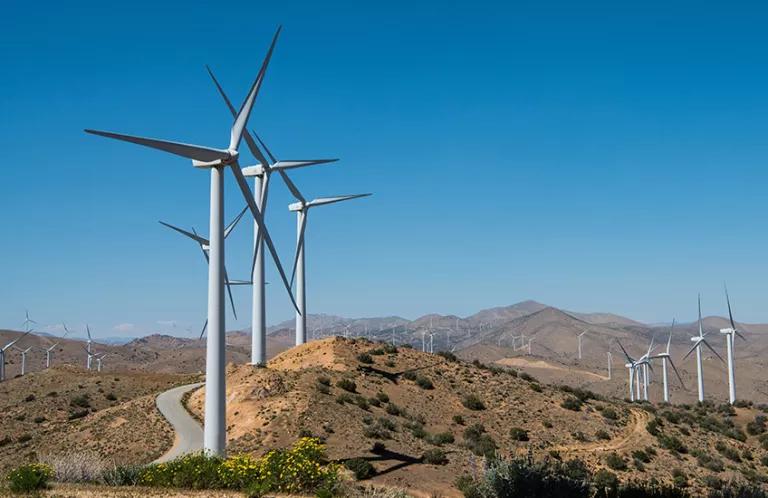California: 10 Years of Climate Commitment & Economic Growth

In the decade since California passed its landmark climate law, the state has undergone one of the longest economic expansions in its history while simultaneously cutting climate pollution. In fact, the latest report from the nonpartisan advocacy group Next 10 shows that the state has outperformed the nation as a whole on both counts.
In its 10th annual California Green Innovation Index comparing California’s economic and environmental indicators with the United States and the rest of the world, Next 10 finds that California has reduced its carbon emissions more than 11 percent since the 2006 passage of Assembly Bill 32—outpacing the United States as a whole—while also growing state economic output nearly 16 percent, compared to 11.6 percent nationwide.
California, which recently surpassed the UK to become the world’s fifth-largest economy, has been steadfast in its climate policies, showing the world what is possible with committed climate action while taking steps to integrate energy equity and ensure access to single family, multifamily, and affordable housing solar and energy efficiency offerings, as well as clean vehicles (including electric vehicles) for all Californians.
The state also hit its 2020 carbon reduction goal four-years early, reducing emissions to 1990 levels by 2016. A focus on clean energy investment, boosting renewable energy, and deploying clean vehicles has helped California grow its economy and create jobs while cutting carbon pollution. However, the report points out that transportation has become the state’s biggest source of emissions—marking a need for increased effort to ensure a smooth transition to reduce pollution from gasoline and scale up deployment and access to electric vehicles for everyone.
Developing a Low-Carbon Economy
The fact that California’s economy has become more productive while emitting less climate pollution counters the long-used argument that you cannot have a healthy environment and a healthy economy at the same time. And the positive gap between California’s increasing productivity and falling emissions has been getting wider.

In 2016, for every $1,000 of GDP (Gross Domestic Product), California emitted 23 percent less pollution compared to 2006, and half as much emissions per $1,000 of output than the country as a whole. Even with a population increase of 8.5 percent in the past decade, California’s total emissions fell. In its economically valuable climate progress, California sets a model not just for the country but for the world. The only major economy to cut more climate pollution over the past decade was the European Union, but they had a growth rate of nearly half that of California’s.
Driving Clean Technology and Innovation
California ranks third in the world, behind China and the United States as a whole, when it comes to clean energy investment. In 2017, investors poured $2.5 billion into U.S. clean energy technology with more than half of that sum going to California companies. That level of investment produces results—more good jobs and more innovation. Employment levels increased 7.8 percent from 2006 to 2016 in California, outpacing the national rise of 6 percent. More than half a million Californians work in clean energy jobs. Also, more than 5 percent of the world’s clean tech patents came out of California in 2017.
Deploying Renewable Energy
California has more than doubled its renewable electricity resources over the past 10 years, with clean energy now accounting for more than 25 percent of the state’s electricity.

Solar energy, alone, has grown by more than 2,500 percent, and wind power is up 128 percent. California's largest privately owned utilities are expected to hit the state’s renewable energy goal of 50 percent renewables by 2020, 10 years early. No wonder the Golden State has set its sights on a groundbreaking new goal of 100 percent carbon-free electricity by 2045. Now it’s time to ensure that we can share our wealth of solar energy with the rest of the West and rely on their clean energy when the sun sets.

Cleaning Up Transportation
In order to meet its climate goals, California needs to make serious cuts in emissions from transportation. In 2016, transportation accounted for 40.5 percent of the state’s climate pollution—the highest percentage since 2006. Three million vehicles were registered between 2006 and 2016. Each one drives farther than ever since the rising cost of housing pushes Californians more distant from their jobs, requiring that they commute longer distances to get to work.
But thankfully, due to smart policies and laws, we are already seeing great progress in this sector. More clean vehicles are hitting California’s roads and we saw the number of zero-emission vehicles in the state rise 38.6 percent from 2016 to 2017. With climate pollution from cars and trucks on the rise, the Trump administration’s attack on clean car standards is truly senseless and will cost drivers more at the pump. Rolling back these standards will have a disastrous effect on the health of Californians and the security of the state’s climate future. California should be able to set the strong health-protective clean car standards the state needs to combat air pollution and climate pollution.

Keeping It Up
In this era of polluter-friendly climate policy from the Trump administration, California is taking on a true leadership role in the climate fight. With strong climate policies, a focus on ensuring energy equity, and a new building solar rooftop and energy efficiency code mandate, California can stay on track to meet its own climate and economic goals while helping lead others to do the same. Now is the time to double down on efforts and take more action to cut pollution, grow our economy, and guarantee an affordable and clean energy future is available to every single Californian.

